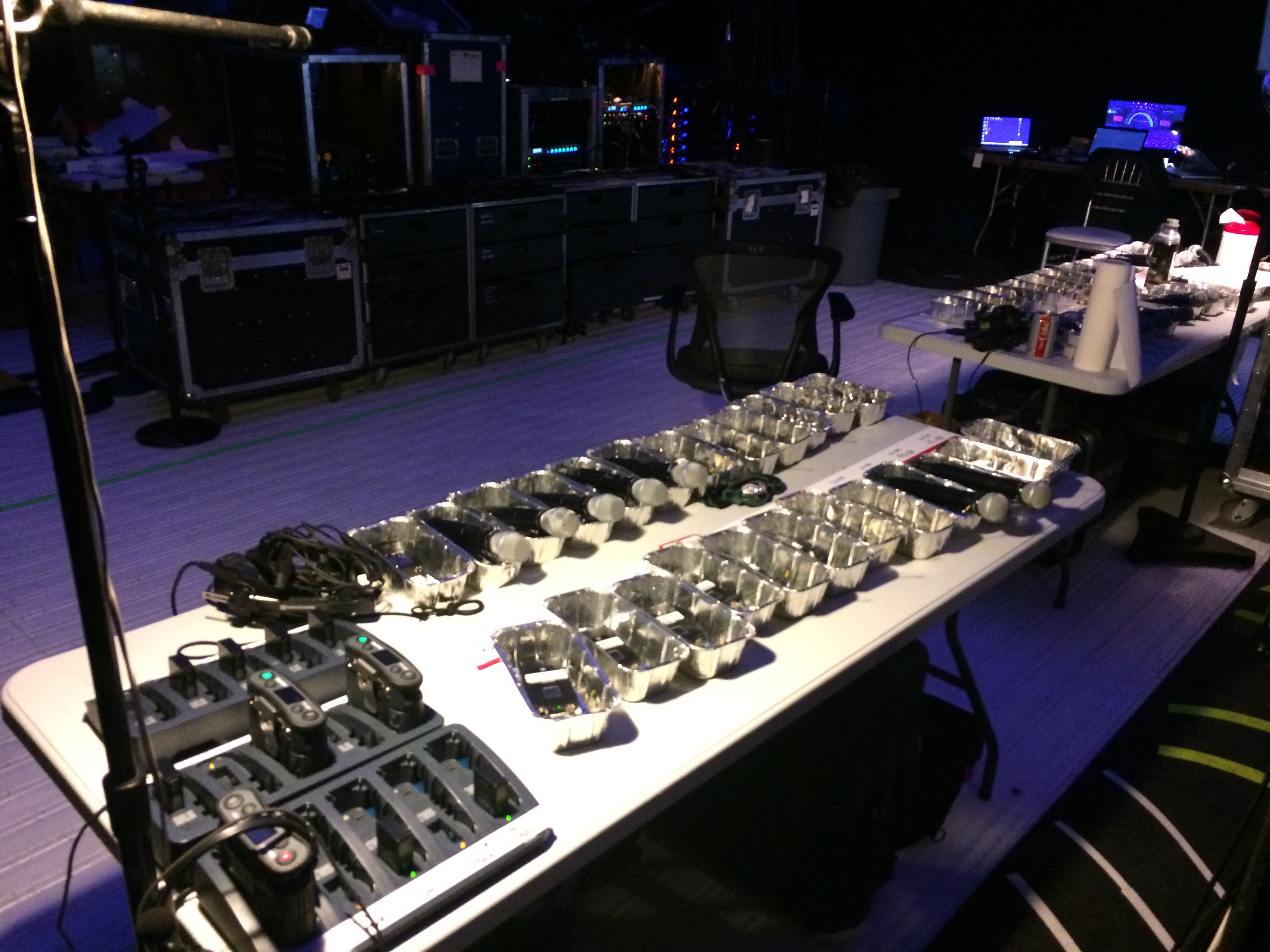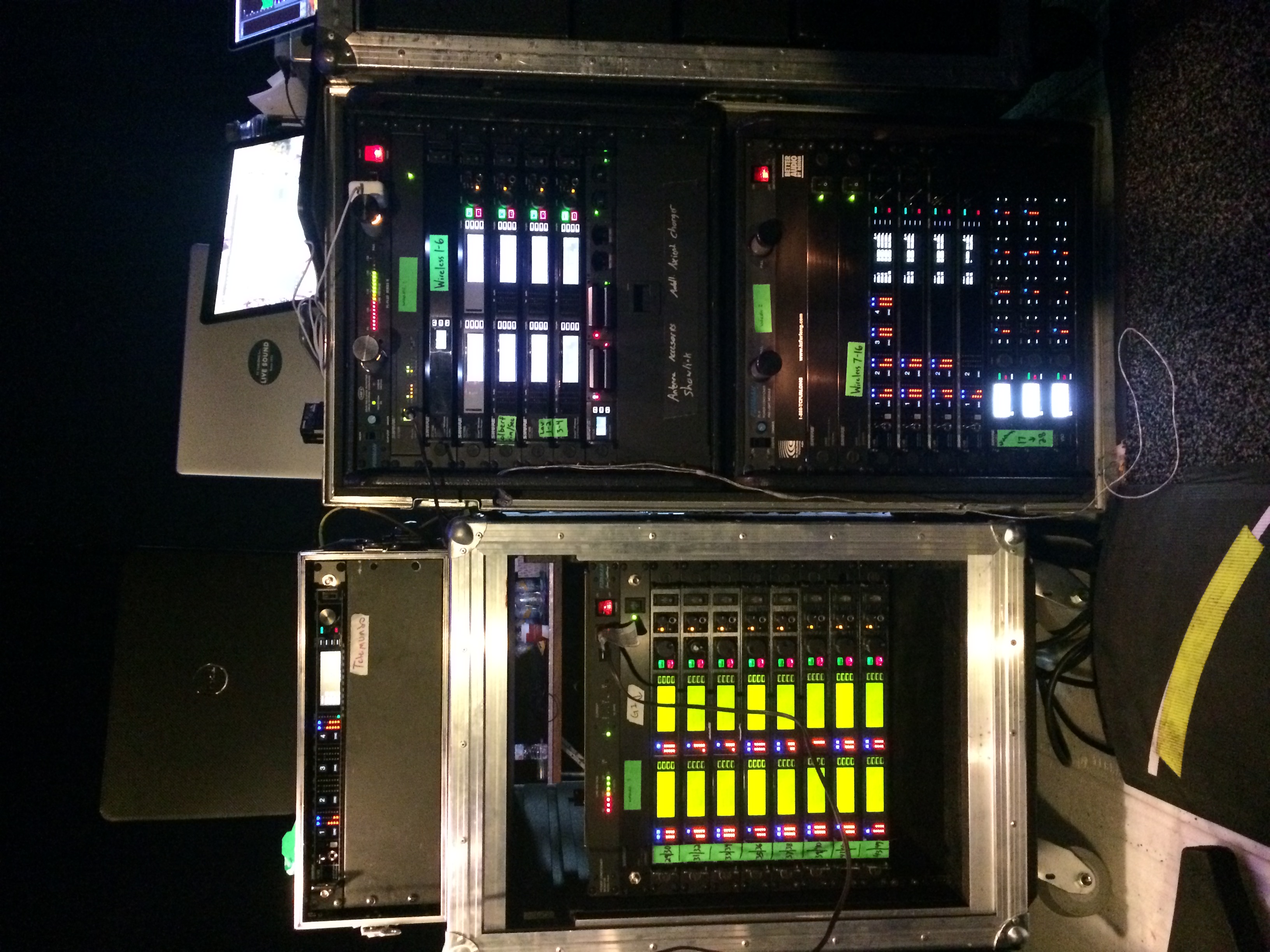
by Andrew Dewar
It’s commonplace for the TC Furlong team to have a position for larger events known as a Wireless Mic Wrangler, whose role ends up being more complicated than it sounds. The Mic Wrangler is ultimately in charge of getting the right packs and microphones to the right people, at the right time and then when the act is done, returning the microphones and packs to their proper home. Below, we lay out some simple ways to effectively “wrangle” high channel count wireless to avoid a catastrophic “wrong mic on stage” type failure at a live event.
Being Prepared is Expected, Not Encouraged
Preparation for live events is 90% of achieving a great show with minimal production errors. Being a Mic Wrangler follows the same approach. The critical document for any seasoned Mic Wrangler is a show flow with the mics going out and the mics coming back for every scene or act depending on the type of event. This allows for two really important things: 1. Front of House, Monitors, and Broadcast all will know exactly which mics will be on stage as well as which mics will not be on stage and 2. It allows the Mic Wrangler to do quick checks such as “how many mics are going out” or “which belt packs should I have in bread pans (more to come on this) during this act”. Finally, a column for names of talent and any capsule or headset information on your show flow is critical and will allow the show to gain another level of sonic quality and consistency.
Microphone location, especially on lavaliers and head worn microphones, makes up a huge component of the sound you get off the capsule and because of this another show document that goes a long way in creating consistent sounding performances is a “Show Bible”. Most of the time we see these in long runs of musical theater performances as they travel across the globe performing in different venues, but we can extrapolate important information from them for one off shows. As the Mic Wrangler you would be most interested in creating pages for the document that give a good visual and written explanation of where mics are located on each person. Some might be very simple and say, “handheld mic” while others might be complex with information like, “black wig clip 2 inches above hair line”. In situations where the mic placement gets complex a picture truly is worth a thousand words and can be good for spot checking mic placement as the talent prepares to enter in the wings.
Organization Allows Preparedness to Thrive
If you’ve got a well written and easy to follow show flow with wireless mic cues, one way to have the hard work not pay off is by allowing yourself to be disorganized during shows and rehearsals. One common industry trend is the use of bread pans or tin bins to not only have a clearly marked place for each transmitter but to also cut down the amount and intensity of intermodulation products created by dozens of transmitters in close proximity to one another. To learn more about intermod and how to avoid it, be sure to check out our recent Wireless Blog Series.

When we bring high channel count wireless onto a show site, we bring along enough tin bins with a few spares and make sure we have more than enough table space to allow each one to sit flat on the table. Once laid out make sure to clearly and consistently label each transmitter, tin bin, and even the table where the bin sits so you can do a cross check at any point in time to make sure everything is cohesive and agrees. Keeping mics and packs for each performer physically separated also decreases the risk of germs and pathogens spreading due to unintentional mixups and sharing of microphones.
Another important level of organization has nothing to do with the physical space we operate in but rather the nomenclature we use to describe each wireless channel. Whether it is “RF 1” or “Wireless 1” or “Allie’s Mic” doesn’t really matter but what does matter is that Front of House, Monitors, Broadcast, and the Mic Wrangler all have the same terms for each channel so communication on coms is quick and efficient. We’ve found that starting with an agreed naming system before rehearsals begin keeps everyone on the same literal page (because you’ve got a well prepped show flow!) and allows us to all “rehearse” using the right names for wireless channels.
Checks and Balances Before and During the Show
A catastrophic mistake that seems to be made far too often is that the first time a microphone goes onto the stage is by the talent as they make their initial entrance during the show. Even if Front of House and Monitors say they see signal coming in pre-show from the mics, an audio crew needs to set aside a few minutes to cycle through the mics and test them before the show on stage. By taking the time to get them on stage and test them we remove 2 possible critical failures from our performance.
First is the possibility that there are some stray wireless frequencies that are causing interference somewhere specifically on stage. Second, it allows us to confirm that the signal passing from the mic to the consoles is clean and won’t feed-back on stage. This is a critical step and can be expedited by having multiple people put on mics and test them on the stage one at a time.
Despite all the planning, testing and organization we still need to have a few ways to navigate the show on the fly. First and foremost, make sure there’s an easy way to quickly see the status of all your transmitters. With networkable Shure systems we tend to put a laptop or a large display near the Mic Wrangler’s position so that during the show they can keep the monitor tab open on Wireless Workbench and see all the transmitters on the display. This can save an act by allowing the Mic Wrangler to spot low batteries, bad RF, and powered off transmitters while deploying the channels to the talent.

Most importantly for a Mic Wrangler, call the show live. The Mic Wrangler can be most effective when they get on coms right before an act and say, “We have RF 1, RF 2, RF 4, RF 6, and RF 9 going on stage for act 7”. The clear communication allows all the engineers to look at their consoles and make sure those channels are unmuted and seeing signal and gives everyone one last check before an incorrect mic is put live in the mix. Even if you’re doing scene to scene pre-programmed shows this technique allows everyone to be on the same page and also builds in the flexibility to make a last minute change if the wireless coordination isn’t holding up or a pack fails during show.
Our extensive rental inventory includes hundreds of channels of wireless mics, IEM, and intercom, along with all the accessories you’ll need to make your next event a success. Reach out to our Rental Team today at rentals@tcfurlong.com or call 847-367-9588.
We are also authorized sales dealers for all major manufacturers of live sound equipment. Reach out to our Sales Team for a quote at sales@tcfurlong.com or 847-367-9588.